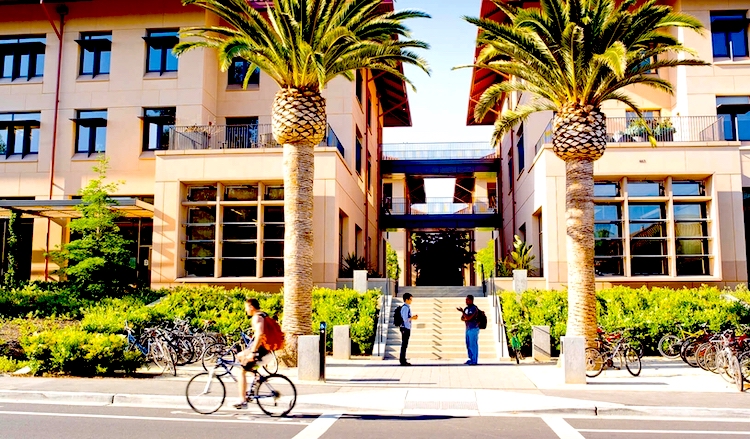
Stanford GSB takes first place in the new Financial Times ranking of executive education programs
The Financial Times long ago crowned IMD the world’s best open-enrollment executive education program. But this year the Lausanne, Switzerland school has company at the top: Stanford Graduate School of Business, which jumped 12 places since 2017 to tie the tiny Swiss school. Meanwhile IESE, in Spain, offers the top customized program; the Barcelona-based school also led a composite ranking.
In its 21st year, FT’s executive education ranking saw little in the way of dramatic upheaval at the top of its three lists. IMD has been ranked the best “open” program — meaning it offers courses on specific topics directed toward professionals regardless of employer — for eight straight years, though this is the first time it has shared the spotlight with Stanford, which was ranked No. 7 last year and 13th in 2017. IESE is no stranger to praise, either, having been named the top customized program for five consecutive years. Customized programs are tailored to the needs of the companies that commission them. It is also IESE’s fifth straight year atop the combined ranking.
Rounding out the top five open programs are the University of Chicago’s Booth School of Business (19th two years ago), the University of Michigan’s Ross School of Business (ninth in 2017), and INSEAD, in France. FT ranked INSEAD fifth last year, as well. For custom programs, following IESE are Duke Corporate Education, a carve-out from Duke University’s Fuqua School of Business with facilities in Durham, North Carolina, as well as San Diego, London, Johannesburg, Singapore, and Ahmedabad, India; IMD, which was also third last year after placing second in 2017; SDA Bocconi of Milan, Italy, up from seventh place last year; and ESSEC, of France, up from 12th. In the combined ranking, after IESE are IMD, HEC Paris, Stanford, and Michigan Ross.
STANFORD PUSHES PAST HARVARD TO BECOME TOP-RANKED U.S. PROGRAM
One very curious absence in the overall ranking: Harvard Business School, which two years ago made news by climbing into the third overall spot. In 2018 HBS slipped to fifth place, but it was still the top U.S. program overall in a very Euro-centric ranking. In 2019, however, HBS disappeared entirely from the list of 50 schools.
Even as HBS dropped out of sight, Stanford rushed in to fill the gap. The Palo Alto, California school earned top marks in three open-program categories (Aims Achieved, Quality of Participants, and Food), and nabbed two second places and a third place, as well. (See below for more on FT’s methodology.) Stanford, of course, needs little introduction, but its executive education offerings are many, growing, and influential, in particular its online LEAD: Personal Leadership Certificate and programs on big data and social impact.
For U.S. schools overall, besides the absence of HBS, the picture is quite similar to the 2018 ranking. Whereas last year’s list had 10 U.S. schools, the 2019 iteration also has 10, among them Columbia Business School at No. 9 and The Wharton School at the University of Pennsylvania at No. 10. Asia is also well-represented, with CEIBS (32nd) and Singapore (34th) returning and two Indian B-schools, the IIMs of Bangalore (43rd) and Ahmedabad (44th), joining the party. Still, it remains a very European party, with more than half the 50 ranked schools located in Europe.
A WORD ABOUT METHODOLOGY
The Financial Times‘ customized ranking features the top 80 B-schools in the field of customized executive education; the second ranking includes the top 80 schools for open-enrollment programs; and the third combined ranking lists the top 50 schools for executive education, calculated from the customized and open tables. To be included, schools must be internationally accredited by either Equis or ACCSB and have garnered revenues of at least $2 million in 2018 from either of their programs. A total of 103 schools took part in either or both rankings this year.
In total, about 1,000 business school clients participated in this 21st year of the FT rankings, roughly the same number as the last two years. The 2019 survey achieved a 40% response rate from organizations. About 4,000 individual participants answered this year’s open program survey — a response rate of 22%.
In open enrollment, respondents evaluated executive programs on 16 criteria. The first 10, including Aims Achieved, Food, Facilities, Course Design, Faculty, and New Skills and Training, account for 80% of the weight. These areas are rated on a 10-point scale where a 10 represents the best performance. The remaining 20% of the weight covers school-supplied data like female and international participation, international location, overall revenue growth, partner schools, and faculty diversity. The customized ranking follows a similar methodology, with slight differences in categories.
As FT puts it, “The weightings accorded to the first nine and 10 criteria in the customized and open rankings, respectively, are determined by the level of importance clients and participants attach to each in their surveys for the 2019 ranking. Weightings for these criteria therefore vary slightly from year to year.”
See the next pages for the top 25 schools in each of The Financial Times‘ open and customized executive education rankings, and details on how FT ranks them in 11 key categories.
DON’T MISS: LAST YEAR’S ANALYSIS OF THE FT EXEC ED RANKING





Questions about this article? Email us or leave a comment below.